The Analysis of Food Substances by ICP-MS
Special Issues
Elemental analysis of food substances presents a challenge because of the wide variety of food types and range of concentrations that need to be analyzed. This article discusses the analysis of a variety of food matrices with a single digestion procedure and instrumental method.
Elemental analysis of food substances presents a challenge because of the wide variety of food types and range of concentrations that need to be analyzed. The complexity of food matrices requires digestion to both break down the matrix and to convert solids into liquids for analysis. ICP-MS has the ability to measure both trace and elevated analyte levels during the same analysis, while the use of cell-based ICP-MS systems can remove the effects of interferences, allowing lower levels to be determined. This article discusses the analysis of a variety of food matrices with a single digestion procedure and instrumental method.
Food safety is an area of growing concern as a result of pollution, which can enter the food supply and be passed along to consumers, leading to health problems. Therefore, it is important that all food types are monitored for contaminants and toxic elements. It is also equally important to monitor levels of nutritionally significant elements, which are present at elevated levels. Much work has been done on the analysis of food substances with inductively coupled plasma–mass spectrometry (ICP-MS) (1–9).
To establish analytical conditions for the determination of metals in a variety of food types, several food standard reference materials have been analyzed for both elevated and trace elemental content using ICP-MS. Emphasis was placed on finding a single set of sample preparation and analytical conditions that would be applicable to a number of different food matrices.

Table I: Standard reference materials analyzed
Experimental
Sample Preparation
The samples analyzed in this study were all standard reference materials from NIST (Gaithersburg, Maryland) and represent a variety of food types. Table I shows the materials analyzed. Approximately 0.5 g of sample was digested in triplicate (along with a blank) with 4 mL of Optima-grade HNO3 (Fisher Scientific, Pittsburgh, Pennsylvania) and 2 mL of Optima-grade H2O2 (Fisher Scientific) in a Multiwave 3000 microwave digestion system (Anton Paar, Graz, Austria). Precleaned HF-100 vessels were used in a 16-position rotor. A pressure–temperature sensor was used to monitor the pressure and temperature of the sample in position 1 of the rotor. The external infrared sensor provided the temperatures for each individual sample in the rotor. The digestion program consisted of 30 min of heating and 15 min of cooling, as shown in Table II. The samples were dissolved completely, resulting in clear solutions that were diluted with 1% HNO3 to a final volume of 50 mL.

Table II: Microwave digestion program
Calibration
Mixed element calibration standards of appropriate concentrations were prepared from PerkinElmer Pure multielement and single element standards (PerkinElmer LAS, Shelton, Connecticut) in 1% HNO3. The following internal standard mix was spiked into each sample, blank, and standard: Sc, Ga, In, and Tm.
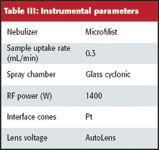
Table III: Instrumental parameters
Instrumental Conditions
All analyses were performed on an ELAN DRC II (PerkinElemerSciex, Concord, Ontario, Canada); instrumental parameters appear in Table III.

Table IV: Reaction cell parameters
Most elements were analyzed in standard mode (that is, no reaction gas in the cell). However, those elements that suffered from interferences were measured in dynamic reaction cell (DRC) mode using oxygen and ammonia as the reaction gases. Because no elements were certified in the sucrose sample, spike recoveries of common elements were measured.
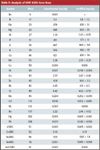
Table V: Analysis of NIST 8433: Corn Bran
Sodium and potassium were measured in standard mode, but with a different Rpa (DC voltage) than other elements. Both of these elements were present at high concentrations in the final solution and are either monoisotopic (Na) or greater than 90% natural abundance at the primary isotope (39K). As a result, it could be difficult to measure these elements in the same sample along with elements present in the low microgram-per-liter range. If the sample is not diluted adequately, Na and K could saturate the detector. If the sample is diluted too much, the other trace elements cannot be measured.
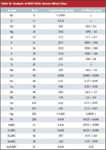
Table VI: Analysis of NIST 8436: Durum Wheat Flour
To solve this problem, the signals from sodium and potassium were attenuated selectively without affecting the sensitivity of other elements (10). This was accomplished by increasing the RPa on the reaction cell quadrupole only for sodium and potassium. Varying the RPa value changes the amount of the attenuation, effectively extending the dynamic range. Table IV shows the reaction cell parameters for the analytes measured in DRC and extended dynamic range modes.
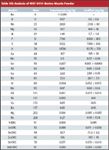
Table VII: Analysis of NIST 8414: Bovine Muscle Powder
All quantitative measurements were made against aqueous, external three- or five-point calibration curves.
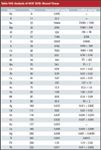
Table VIII: Analysis of NIST 2976: Mussel Tissue
Results
Tables V–X show results for the various food matrices analyzed. The majority of results are within the certified ranges, demonstrating the robustness and applicability of the methodology for various food types.
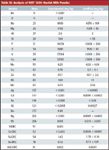
Table IX: Analysis of NIST 1549: Nonfat Milk Powder
Conclusions
This work has demonstrated the ability to analyze a variety of food samples accurately for elements present at both trace and nutritional levels. A single microwave digestion procedure and ICP-MS method were used for all samples, demonstrating their robustness and flexibility. The ability to attenuate the intensities of specific elements selectively without affecting other isotopes allows for the analysis of both trace and high-level analytes to be performed using a single dilution. The analytical results show that microwave digestion followed by ICP-MS analysis effectively measures both toxic and nutritional elements in a variety of food matrices.

Table X: Analysis of sucrose
Cynthia Bosnak, Ewa Pruszkowski, and Kenneth Neubauer are with PerkinElmer, Waltham, Massachusetts.
References
(1) Y-T Chang and S-J Jiang, J. Anal. At. Spectrom. 23(1), 140 (2008).
(2) M. Resano, E. Garcia-Ruiz, L. Moens, and F. Vanhaecke, J. Anal. At. Spectrom. 20(2), 81 (2005).
(3) R.B. Myors, R. Hearn, and L.G. Mackay, J. Anal. At. Spectrom. 20(3), 216 (2005).
(4) M. Shah, R.G. Wuilloud, S.S. Kannamkumarath, and J.A. Caruso, J. Anal. At. Spectrom. 20(3), 176 (2005).
(5) C. Fragniere, M. Haldimann, A. Eastgate, and U. Krahenbuhl, J. Anal. At. Spectrom. 20(7), 626 (2005).
(6) C.R. Quetel, J.P. Snell, Y. Aregbe, L. Abranko, Zs. Jokai, C. Brunori, R. Morabito, W. Hagan, S. Azemard, E. Wyse, V. Fajon, M. Horvat, M. Logar, O.F.X. Donard, E. Krupp, J. Entwisle, R. Hearn, M. Schantz, K. Inagaki, A. Takatsu,P. Grinberg, S. Willie, B. Dimock, H. Hintelmann, J. Zhu, E. Blanco Gonzalez, G. Centineo, J. Ignacio Garcia Alonso, A. Sanz-Medel, and E. Bjorn, J. Anal. At. Spectrom. 20(10), 1058, (2005).
(7) D. Hammer, M. Nicolas, and D. Andrey, At. Spectrosc. 26(6), 203 (2005).
(8) W. Dufalilly, L. Noel, and T. Guerin, Anal. Chim. Acta 565, 214 (2006).
(9) M.A. Knopp, F. Chan, and K.R. Neubauer, Analysis of Food Substances with Dynamic Reaction Cell ICP-MS, PerkinElmer Field Application Report, 2004.
(10) F. Abou-Shakra, "Extending the Dynamic Range of the ELAN DRC by Selective Attenuation of High Signal" PerkinElmer Field Application Report 007437_01 (2005).
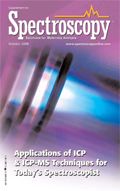
Trending on Spectroscopy: The Top Content of 2024
December 30th 2024In 2024, we launched multiple content series, covered major conferences, presented two awards, and continued our monthly Analytically Speaking episodes. Below, you'll find a selection of the most popular content from Spectroscopy over the past year.
Best of the Week: Hyperspectral Imaging, ICP-MS Analysis of Geological Samples, Product Roundup
October 18th 2024Top articles published this week include an article about hyperspectral imaging in human skin research, a peer-reviewed article about analyzing geological samples using atomic spectroscopy techniques, and an equipment roundup piece about the latest products in the industry.
Analyzing Mercury Isotopes: A SciX Interview with Frank Vanhaecke, Part 2
October 17th 2024In this preview to the upcoming SciX 2024 conference next week, Spectroscopy sat down with Frank Vanhaecke to discuss about his educational background and what he is looking forward to about the upcoming conference.